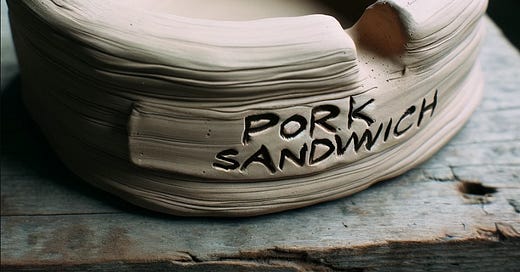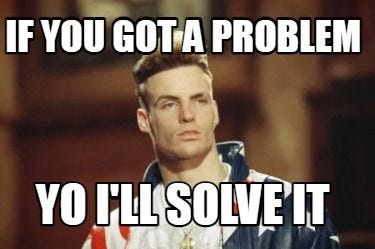At 14, I was introduced to the magical properties of the kiln. In goes a blob of nondescript clay, roughly shaped, littered with jagged ridges and haphazard thumb prints.
2000 degrees later, voila, a somewhat recognizable artifact. A knick-knack, but also a lasting physical testament to the fledgling artistic skill of its creator. And by lasting, I mean it will be found in a landfill many eons from now when automated cleanup droids are restoring the planet.
It turned out, to my utter ambivalence, that if you baked clay in a really hot oven, you could make its shape a permanent affliction upon the world. This according to Mr. Gopnik, the rotund and bespectacled art “teacher” upon whom I relied for such novel insights.
We had a project, which was to create something we could use around the house. Upon completion of our molding, or the expiration of time available for such molding, the objects would be baked. We would then paint them, or not, and take them home.
Gopnik issued two rules for the task.
“First, no fruit.”
He pretended it was because the density of the objects made them un-bakeable in the kiln, remaining somewhat dissolute at their cores and therefore lacking the structural integrity to mar a curio shelf for the requisite number of decades.
The actual reason was more scandalous. An entire class of twenty-three eighth-graders, rallied by three miscreant boys all surnamed Baker but unrelated, had crafted clay phalluses, claiming they were actually bananas. Indecisive in the face of the dilemma, the unfortunate Gopnik had allowed the objects to be baked and painted.
Suddenly our town was awash with mantelpieces featuring these artisan kiln-baked mementos. Mortified grannies city-wide needed a second glass of sherry with dinner.
Feigning a shock to their alleged conservative values, parents wondered aloud where their sweet children would have gotten such an idea. One might be tempted to blame the three Bakers, but they were merely mirrors reflecting the decrepitude of the at-large kid populous.
Gopnik avoided the sack by promising to provide clearer guidance to future students. Hence, the fruit prohibition.
And while the Bakers had guaranteed the whole school knew the real reason, Gopnik’s furnished rationale also made sense, and was generally accepted.
The second rule: no ashtrays.
For this rule, he provided no justification. Just an arbitrary constraint and a “because I said so.”
Before having heard the rules, my plan was to make a small bowl for my dad’s peanuts. The old man could put away a farmed hectare’s worth in a single episode of his favorite sasquatch hunting show.
When he reached the bottom third of the jar, it became a grim spectacle as he fumbled around to get at the last bits, licking the salt from his fingers before repeating the cycle with increasingly gobby paws.
A decent bowl could end all that. And since my parents lacked the imagination or creative impulse to produce a bowl, and for whatever reason chose not to purchase one from the store, I would exploit my newfound kiln access to show them how it was done.
My plan was for a shallow, sloping bowl with ample payload. Importantly it would be big enough for the old man to get his grimy mitts in there easily. These were the early machinations of the burgeoning military tactician within.
But then Gopnik came along and told me what I couldn’t do. And that instantly changed my plan.
I became ideologically committed to creating an ashtray. Not because my parents both smoked, although it was the case, and that would have been a constructive reason.
But simply because there was an unjustified rule saying I couldn’t. It became more important to me to defy the rule than to actually create something meeting the intent of the exercise.
Upon seeing that I had created what was clearly intended to function as an ashtray, Gopnik challenged me and asked why I had broken the rule.
“That’s not an ashtray. It’s just a plate for a sandwich.”
“Then why does it have little slots on the side that look like resting places for cigarettes?”
“Those are just to put a few french fries, or a small pickle, or a toothpick. It’s a new feature.”
Finding my logic immutable and having better things to do, Gopnik shook his dismayed head and moved along, telling me I needed to label my plate to make it obvious what it was.
Being the wryly clever operator I was, I simply scrawled something fictitious on the side to cover myself. Influenced by a recent screening of John Hughes’ terrible teen caper “Weird Science,” I imagined my ashtray as the vessel for a pork sandwich, and labeled it thusly.
Several of my classmates followed my lead, flooding the kiln with stealth ashtrays.
But a majority stayed within the bounds set for them. They created a dozen variations of lame bowls. A pointless exercise for all involved, but at least the landfills wouldn’t go wanting.
There is a lesson here for organizational leadership, and I have seen it play out dozens of times.
Put people in a narrowly defined space and you will get either compliance or defiance.
Every thick line you draw to bound the conceptual canvas of activity imposes a psychological constraint. Something the participants aren’t allowed to do. They become more focused on staying inside the boundaries than on creating. They’re stifled. But they are compliant, and doing exactly what you (said you) wanted.
Others, like the antagonistic, self-amusing, easily triggered lad in the story above (who maintains the same temperament to this day) will feel disempowered by the imposition of too many limits. You can ease that feeling of lost power by explaining why a limit is necessary, but if you refuse to do so or spout gibberish, your actions will feel coercive, the reins too tight.
As a general given rule, when you make people feel disempowered, they will find a way to feel more power.
In the kind of situation abstracted here, they may test boundaries without exposing themselves to the culpability of clearly violating them. They are defiant, creating something which actively nullifies the purpose of the activity.
Whether the limits you impose engender defiance or compliance, they take energy away from creativity.
If innovation is your goal, define as big a conceptual space as you can, impose as few limits as possible, and make the boundaries fuzzy enough that people don’t feel mentally constrained.
When you put people in an open space, you stand a much better chance of getting their best. And to innovate, you need exactly that.
Everything I say here makes natural sense. Put a lion in a cage, and it will try to get out until it realizes it can’t, at which point it will sit passively. Give a lion space to roam, and it will find the best hunting ground.
Unfortunately, this basic idea often gets lost in organizations as they grow, becoming more beholden to myriad stakeholders, more exposed, and more risk averse.
There is a lot of talk about “safe innovation” from executives these days. But this is a free range oxymoron.
Amazon’s CFO Brian Olsavsky said recently that the company would “continue to invest in new things and new areas and things that are resonating with customers.”
I don’t know what that means exactly, but it sounds like the approach is to make sure something will hit with customers before investing in it.
That imposes a fatal limit on creativity, essentially testing a proposal’s return-on-investment before it can even stand in the cradle.
Maybe we can argue that’s a decent framework for incremental improvement in a cost-sensitive environment.
But it’s a horrific framework for innovation, which is less about giving customers something already resonating with them and more about giving them something they haven’t even imagined yet, but you’re certain they will love.
You don’t find those sorts of ideas by telling people to make different forms of clay bowls.
Amazon’s mass layoffs and reduced focus on new products and services reflect a desire to grow by shrinking. This doesn’t work. It provides short term relief from cost pressure at the expense of long-term success, because shrinking the space in which people create makes ingenuity too rare to seed the future.
Great companies become great because they create new things.
They regress into mediocrity by pushing their people and culture into creative frustration, resulting in a comply or defy response to onerous limits on thought.
True creation means taking the chance your efforts might come to nothing. Like what happened with my sandwich tray.
The Radar is a free newsletter supported by its readers through pay-what-you-want subscriptions. Want to make sure you never miss an essay? Subscribe in a few clicks. Thank you for reading!
TC is a writer, speaker, and leadership consultant with more than thirty years in the arena as a combat pilot, commanding officer, operations director, and veteran voice.








